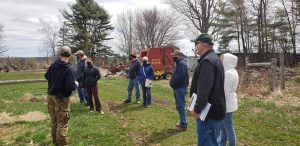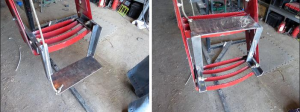AgrAbility News for April 2021
Maine AgrAbility News
- University of Maine Cooperative Extension and Maine AgrAbility were recently awarded an Extension Risk Management Education Grant to support their Boots-2-Bushels (B2B) program. B2B is a comprehensive nine-month market gardening education and training program for military veterans, their family members, and farmers with disabilities in Maine.

The program includes ten weeks of subject matter instruction and six months of hands-on production. The B2B program uses the “Five Fs” framework (Farming, Family, Finances, Future, Fitness) to address production, marketing, financial, and human sources of agricultural risk, and creates a near-peer cohort that fosters unit cohesion in an empathetic, therapeutic environment. The 18-month ERME grant will provide support for hands-on field work at a demonstration farm in 2021 and 2022, intensive individual follow-up in both years, and instruction and fieldwork in 2022. Most recently, B2B farm students had their first field trip to King Hill Farm in Penobscot, ME, to learn about harvest and storage, including its wash and pack building.
- During April, staff used outreach efforts to engage new audiences in Maine, including sharing resources with Native American tribes and commercial fishermen. Brie Weisman, OT, has started a monthly news post to the Commercial Fisheries News publication. The March 2021 article introduced FishAbility, a program of Maine AgrAbility, and the April 2021 issue focused on fishermen and back pain.
National AgrAbility News
- AgrAbility/North Central FRSAN webinar: “African American Farmers: Stress Issues and Solutions.” Thursday, May 27, 3:00 – 4:00 p.m. EDT. Register at www.agrability.org/online-training/upcoming.
- The National AgrAbility Project has started its fourth month of NTW virtual sessions. They have all been recorded and are available on the NAP website HERE.
Toolbox Spotlight
 By following these Added Step Plans, one can produce a device to help reduce strain on knees when climbing on or off the tractor, combine, or other equipment. The step flips up and down with a rope and stays in place while driving. (Those who don’t need the extra step can simply leave it folded up, stepping on it in place.) The online instructions include a list of supplies needed as well as the text and pictures on how to make and mount the step.
By following these Added Step Plans, one can produce a device to help reduce strain on knees when climbing on or off the tractor, combine, or other equipment. The step flips up and down with a rope and stays in place while driving. (Those who don’t need the extra step can simply leave it folded up, stepping on it in place.) The online instructions include a list of supplies needed as well as the text and pictures on how to make and mount the step.
